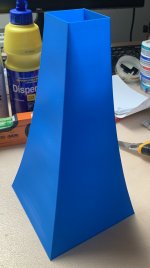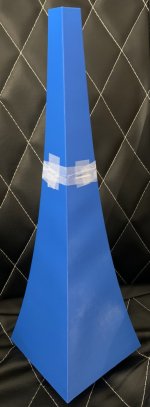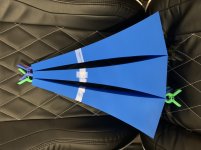Proof of concept - lower part of a single cell printed in vase mode (PLA). With 0.4 mm nozzle, it feels a bit fragile, but might work when glued together and filled with polyester resin. Wall thickness is around 0.5 mm. I will try to print with 1 mm nozzle from PETG for a little extra strength. With a large nozzle, one cell prints in ca 2 hrs in two parts and consumes around 100 g of filament. A pair of 5x3 horns could be printed with 4 kg of filament (the extra spool would be for the adapters).
Attachments
I am printing from leftover filament, so the prototype will be an ugly multicolor monster I was advised against poyester resins - in the end, the casting material will need to be tested anyway. I have three cells printed, they need to be glued together and also test prints of the front spacers will be done today. And then, there comes the nightmare of 3D modeling the adapter for the driver
I was advised against poyester resins - in the end, the casting material will need to be tested anyway. I have three cells printed, they need to be glued together and also test prints of the front spacers will be done today. And then, there comes the nightmare of 3D modeling the adapter for the driver
What's the difference of a multicell horn and a singular horn of the same dimensions and paramteres, physically spoken and regarding the outcome?
I'm curious about this too. I would like to have multicells simply because they look cool... but they don't seem to have any other benefit. The OP, as the payoff for all their effort, got a horn that looked good, but did not meet their expectations ("I would not cross them lower than 400-500 Hz. this is something that I found out after the horns were built. My intention was to use it from 350-400 Hz." -post 12).
Based on a skim of this mega thread, and looking at other multicell projects, 500-2000Hz seems to be their optimal range. e.g. these look well made, used a more rare / premium / $$ driver, but had exactly the same bandwidth:
DIY horn multicell (18 cell))
It looks like, for a lot less effort, you can get the same HF upper limit, and the same coverage angle, and similar efficiency, and more LF capability by sticking something like this: B&C 5NSM38 is a lightweight 5" closed back midrange speaker - B&C Speakers - B&C 5NSM38 neodymium 5" closed back midrange speaker. B&C 5NSM38 neodymium closed back, open baffle and infinite baffle midrange speakers available now. ...onto a constant directivity horn.
A quick search shows that the OP has done (approximately) this. He sold the multicells, and was making Synergy clones:
HiFiForum.nu - The Swimergy horn
---
Assuming that the goal is
- a multicell (because it looks cool)
- roughly 500Hz - 2kHz (but 350Hz would be better)
....why use a modern printer to build a 1930's horn and bolt on a 1980's compression driver?
Compression drivers have a low Xmax forced on them by the tight spacing between the diaphragm and base of the phase plug. This is good engineering / an acceptable compromise for a driver, like the JBL 2445 that the OP used, which is intended to play > 10kHz. These compromises do not make sense for an application that only goes to 2kHz. A direct radiator makes more sense, IMO.
Also, when bolting a vintage compression driver onto a vintage multicell horn, there are a lot of discontinuities in the path between the diaphragm and the room.
(1) single (tiny) air space in front of the diaphragm
(2) multiple phase plug slits (tiny channels)
(3) conical snout section (multiple paths merge into a single air space)
(4) horn adapter (conical to rectangular transition)
(5) horn cells (split into multiple paths again)
All of the initial plumbing is there to optimise HF. That is pointless in an application that only goes to 2kHz.
That is: if you use a direct radiator, and simply print the cells of the horn so that they go all the way to the driver, you could cut out (2) (3) and (4) from the above list.
Why 3D print a multicell horn? Why not Joseph Crowe is preparing a sintered metal 3D printed multicell horn and it just reminded me I could get back to this old project with some new ideas. It came in the right time since my 3D printers are not doing much these days and I have a pair of JBL2445s that need larger and better horns than the 2380 clones I am using now. The "lego" approach to building a multicell horn seems to work pretty well. I am following also the ATH4 thread closely and will most probably end up with either a large freestanding horn (but that one will need me to buy a new set of 1" drivers). And it is also kind of fun to follow the "pioneers", as GM calls them, so my list of projects also includes bulding some Smith horns, maybe also Yuichi style on a CNC or mixed CNC/3D printing.
Joseph Crowe is preparing a sintered metal 3D printed multicell horn and it just reminded me I could get back to this old project with some new ideas. It came in the right time since my 3D printers are not doing much these days and I have a pair of JBL2445s that need larger and better horns than the 2380 clones I am using now. The "lego" approach to building a multicell horn seems to work pretty well. I am following also the ATH4 thread closely and will most probably end up with either a large freestanding horn (but that one will need me to buy a new set of 1" drivers). And it is also kind of fun to follow the "pioneers", as GM calls them, so my list of projects also includes bulding some Smith horns, maybe also Yuichi style on a CNC or mixed CNC/3D printing.
I would like to have multicells simply because they look cool... but they don't seem to have any other benefit. The OP, as the payoff for all their effort, got a horn that looked good, but did not meet their expectations ("I would not cross them lower than 400-500 Hz. this is something that I found out after the horns were built. My intention was to use it from 350-400 Hz." -post 12)
LOL. This gave me quite a chuckle. Cool is in the eye of the beholder
I'm not sure why the OP thought he could cross the horns lower than about 450, but that's not a fault of the horn. You need the right horn and the right driver to cross low. The sweet spot for most common multi-cell horns is 650-700 Hz. That where I crossed my 1005s and have also done the same with 1505s and even 803. The 803 is supposed to go down to 300Hz, but you need the right driver for it. My Altec 290 "Giant Voice" compression drivers with the phenolic diaphragms would almost play the low, as that is their rating. But they struggled. Now I am running a BMS coaxial driver on the 803s and crossing somewhere around 400Hz with no problem. I use them 6 days a week in a 2200 seat amphitheater, which requires a lot more SPL than they did in my garage listening room.
Yes, I also like the Danley Synergy horns, Dr. Tom has done not only amazing work on the horn design, but also the crossovers - and that is vitally important. At one point we were going to compare the SH50 to my Altec multi-cell system, but ti never happened. Horns need careful and clever crossover work to sound their best, and that's not a skill everyone has. I just barely do.
hollowboy,
I have to state that my #392 wasn't referring to your #391, but to pano's #390 instead. Sorry for the confusion . I hadn't read your posting before.
. I hadn't read your posting before.
I can't tell if the effort in the 6x3 multicell in the audioheritage thread (thanks for the link !) is less or more than the OP's original wooden horn. Anyway I think it is much simpler and better reproducible to form exponential vanes from thin laminated wood by using a template, or 3D printing, instead of carving them out of thick wood.
!) is less or more than the OP's original wooden horn. Anyway I think it is much simpler and better reproducible to form exponential vanes from thin laminated wood by using a template, or 3D printing, instead of carving them out of thick wood.
My initial question was if a horn of the same outer dimensions, but without any vanes within, will have comparable properties or not.
Best regards!
Edit: I appreciate your idea of using a common cone driver instead of the suggested JBL 2445's. This might even ease the construction of an adapter to the horn. The adapter itself might be designed as a compression chamber, no?
I have to state that my #392 wasn't referring to your #391, but to pano's #390 instead. Sorry for the confusion
I can't tell if the effort in the 6x3 multicell in the audioheritage thread (thanks for the link
 !) is less or more than the OP's original wooden horn. Anyway I think it is much simpler and better reproducible to form exponential vanes from thin laminated wood by using a template, or 3D printing, instead of carving them out of thick wood.
!) is less or more than the OP's original wooden horn. Anyway I think it is much simpler and better reproducible to form exponential vanes from thin laminated wood by using a template, or 3D printing, instead of carving them out of thick wood.My initial question was if a horn of the same outer dimensions, but without any vanes within, will have comparable properties or not.
Best regards!
Edit: I appreciate your idea of using a common cone driver instead of the suggested JBL 2445's. This might even ease the construction of an adapter to the horn. The adapter itself might be designed as a compression chamber, no?
Last edited:
-a step backwards and a toy but saw someone at Partsexpress say this little cone speaker worked well (within limits) on a horn
https://www.mouser.com/ProductDetail/PUI-Audio/AS06608PS-R?qs=e16JbV5WBEt7ZuWacVcKBw==
Re: 5NSM38, gap height = 6mm and winding height =7mm - wonder how linear its stated 2.2mm excursion is with regards to compression effects?
hey Pelanj - you'll probably like the Smith DSH - they get kinda weak on the outside angle, really inert construction and a holographic sound. (perhaps best for mono ?)
https://www.mouser.com/ProductDetail/PUI-Audio/AS06608PS-R?qs=e16JbV5WBEt7ZuWacVcKBw==
Re: 5NSM38, gap height = 6mm and winding height =7mm - wonder how linear its stated 2.2mm excursion is with regards to compression effects?
hey Pelanj - you'll probably like the Smith DSH - they get kinda weak on the outside angle, really inert construction and a holographic sound. (perhaps best for mono ?)
I'm curious about this too. I would like to have multicells simply because they look cool... but they don't seem to have any other benefit.
Properly done they have a much flatter polar/power response over a wider BW than a similarly rated single cell's rising on axis horn or even Altec's own Mantaray IIRC [attached Altec 'vintage' horn measurements].
Attachments
All of the initial plumbing is there to optimise HF. That is pointless in an application that only goes to 2kHz.
?? The originals were rated @ 8 kHz for movies and later 12.5 kHz and with 'modern' drivers, up to 15 kHz.
"The originals were rated @ 8 kHz for movies"
Yes, they are capable of making sound beyond 2kHz. But the OP stated they had odd artifacts when he tried a higher crossover, and 2kHz is what he went with.
The similar project I linked also went with a 500Hz - 2kHz bandwidth.
...so it seems that in a modern home system, where the multicells are being compared to other modern devices, their optimal range is pretty narrow.
Yes, they are capable of making sound beyond 2kHz. But the OP stated they had odd artifacts when he tried a higher crossover, and 2kHz is what he went with.
The similar project I linked also went with a 500Hz - 2kHz bandwidth.
...so it seems that in a modern home system, where the multicells are being compared to other modern devices, their optimal range is pretty narrow.
- Home
- Loudspeakers
- Multi-Way
- The construction of a multicell horn


